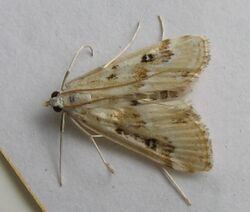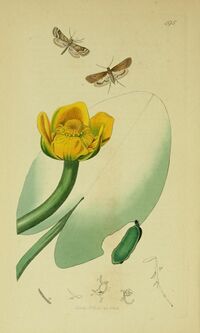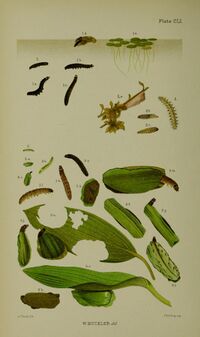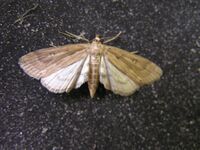Biology:Parapoynx stratiotata: Difference between revisions
John Stpola (talk | contribs) (fixing) |
NBrushPhys (talk | contribs) (fix) |
||
| Line 23: | Line 23: | ||
'''''Parapoynx stratiotata''''', the '''ringed china-mark''', is a [[Biology:Moth|moth]] of the family [[Biology:Crambidae|Crambidae]]. The species was first described by [[Biography:Carl Linnaeus|Carl Linnaeus]] in his 1758 [[Biology:10th edition of Systema Naturae|10th edition of ''Systema Naturae'']]. It is found in Europe where the distribution area extends in the north to the British Isles including Ireland and in the south to Sardinia, Sicily and Greece. The species is also found across the Palearctic in North Africa, Lebanon, Turkey, Azerbaijan, Kyrgyzstan, Uzbekistan and China.. | '''''Parapoynx stratiotata''''', the '''ringed china-mark''', is a [[Biology:Moth|moth]] of the family [[Biology:Crambidae|Crambidae]]. The species was first described by [[Biography:Carl Linnaeus|Carl Linnaeus]] in his 1758 [[Biology:10th edition of Systema Naturae|10th edition of ''Systema Naturae'']]. It is found in Europe where the distribution area extends in the north to the British Isles including Ireland and in the south to Sardinia, Sicily and Greece. The species is also found across the Palearctic in North Africa, Lebanon, Turkey, Azerbaijan, Kyrgyzstan, Uzbekistan and China.. | ||
[[Image:Parapoynx stratiotata FvL.jpg|thumb|left|200px|Female]] | [[Image:Parapoynx stratiotata FvL.jpg|thumb|left|200px|Female]] | ||
[[Image:Britishentomologyvolume6Plate495.jpg|thumb|left|200px|Illustration from John Curtis's ''British Entomology'' Volume 6]] | [[Image:Britishentomologyvolume6Plate495.jpg|thumb|left|200px|Illustration from [[John Curtis (entomologist)|John Curtis]]'s ''British Entomology'' Volume 6]] | ||
[[Image:Buckler W The larvæ of the British butterflies and moths PlateCLI.jpg|thumb|200px|left|Figs 2 larva after final moult 2a cocoon on ''Anacharis alsinastrum'' 2b 2c dorsal and ventral aspects of pupa from William Buckler''The Larvae of the British Butterflies and Moths'' ]] | [[Image:Buckler W The larvæ of the British butterflies and moths PlateCLI.jpg|thumb|200px|left|Figs 2 larva after final moult 2a cocoon on ''Anacharis alsinastrum'' 2b 2c dorsal and ventral aspects of pupa from [[William Buckler]]''The Larvae of the British Butterflies and Moths'' ]] | ||
The [[Wingspan|wingspan]] is 20–24 mm for the males and 28–30 mm for the females. The forewings are pale ochreous brownish, sometimes partly suffused with white in disc ; lines white, first indistinct, posteriorly partly edged with dark brown, second sinuate, anteriorly suffusedly edged with dark brown ; a white discal spot, edged with dark fuscous ; a white subterminal streak. Hindwings are white; a thick dark fuscous postmedian line ; a fine dark subterminal line ; termen yellow-tinged. The larva with eight series of groups of fleshy filaments, serving as branchiae ; whitish-ochreous or pale greenish, slightly purplish freckled; dorsal line rather dark grey ; head pale brown.<ref>Meyrick, E., 1895 ''A Handbook of British Lepidoptera'' MacMillan, London [https://archive.org/details/handbookofbritis00meyr/page/n7 pdf] {{PD-notice}} Keys and description</ref> | The [[Wingspan|wingspan]] is 20–24 mm for the males and 28–30 mm for the females. The forewings are pale ochreous brownish, sometimes partly suffused with white in disc; lines white, first indistinct, posteriorly partly edged with dark brown, second sinuate, anteriorly suffusedly edged with dark brown; a white discal spot, edged with dark fuscous; a white subterminal streak. Hindwings are white; a thick dark fuscous postmedian line; a fine dark subterminal line; termen yellow-tinged. The larva with eight series of groups of fleshy filaments, serving as branchiae; whitish-ochreous or pale greenish, slightly purplish freckled; dorsal line rather dark grey; head pale brown.<ref>Meyrick, E., 1895 ''A Handbook of British Lepidoptera'' MacMillan, London [https://archive.org/details/handbookofbritis00meyr/page/n7 pdf] {{PD-notice}} Keys and description</ref> | ||
The moth flies from May to September depending on the location. | The moth flies from May to September depending on the location. | ||
| Line 37: | Line 37: | ||
==References== | ==References== | ||
{{Reflist}} | {{Reflist}} | ||
==Further reading== | |||
*Mark Parsons, Sean Clancy, David Wilson ''A Guide to the Pyralid and Crambid Moths of Britain and Ireland'': Atropos, England. {{ISBN|9780955108648}} | |||
==External links== | ==External links== | ||
{{Commons}} | {{Commons}} | ||
{{Wikispecies}} | |||
*[http://www.lepiforum.de/lepiwiki.pl?Parapoynx_stratiotata Lepiforum.de] | |||
* [https://web.archive.org/web/20120729194522/http://waarneming.nl/soort.php?id=8471 ''Waarneming.nl''] {{in lang|nl}} | * [https://web.archive.org/web/20120729194522/http://waarneming.nl/soort.php?id=8471 ''Waarneming.nl''] {{in lang|nl}} | ||
* [http://webh01.ua.ac.be/vve/Checklists/Lepidoptera/Crambidae/Pstratiotata.htm ''Lepidoptera of Belgium''] | * [http://webh01.ua.ac.be/vve/Checklists/Lepidoptera/Crambidae/Pstratiotata.htm ''Lepidoptera of Belgium''] | ||
Latest revision as of 17:38, 20 July 2025
| Parapoynx stratiotata | |
|---|---|

| |
| Male | |
| Scientific classification | |
| Domain: | Eukaryota |
| Kingdom: | Animalia |
| Phylum: | Arthropoda |
| Class: | Insecta |
| Order: | Lepidoptera |
| Family: | Crambidae |
| Genus: | Parapoynx |
| Species: | P. stratiotata
|
| Binomial name | |
| Parapoynx stratiotata (Linnaeus, 1758)
| |
| Synonyms | |
| |
Parapoynx stratiotata, the ringed china-mark, is a moth of the family Crambidae. The species was first described by Carl Linnaeus in his 1758 10th edition of Systema Naturae. It is found in Europe where the distribution area extends in the north to the British Isles including Ireland and in the south to Sardinia, Sicily and Greece. The species is also found across the Palearctic in North Africa, Lebanon, Turkey, Azerbaijan, Kyrgyzstan, Uzbekistan and China..


The wingspan is 20–24 mm for the males and 28–30 mm for the females. The forewings are pale ochreous brownish, sometimes partly suffused with white in disc; lines white, first indistinct, posteriorly partly edged with dark brown, second sinuate, anteriorly suffusedly edged with dark brown; a white discal spot, edged with dark fuscous; a white subterminal streak. Hindwings are white; a thick dark fuscous postmedian line; a fine dark subterminal line; termen yellow-tinged. The larva with eight series of groups of fleshy filaments, serving as branchiae; whitish-ochreous or pale greenish, slightly purplish freckled; dorsal line rather dark grey; head pale brown.[1]
The moth flies from May to September depending on the location.
The larvae feed on Nymphaea alba, Potamogeton, Callitriche, Ceratophyllum demersum, Elodea canadensis, Nuphar lutea and Stratiotes.
Subspecies
- Parapoynx stratiotata stratiotata
- Parapoynx stratiotata maroccanum Speidel, 1982 (Morocco)[2]
References
- ↑ Meyrick, E., 1895 A Handbook of British Lepidoptera MacMillan, London pdf
 This article incorporates text from this source, which is in the public domain. Keys and description
This article incorporates text from this source, which is in the public domain. Keys and description
- ↑ Agassiz, David J. L. (2012). "The Acentropinae (Lepidoptera: Pyraloidea: Crambidae) of Africa". Zootaxa 3494: 1–73. doi:10.11646/zootaxa.3494.1.1. ISBN 978-1-86977-986-3. http://www.mapress.com/zootaxa/2012/f/z03494p073f.pdf.
Further reading
- Mark Parsons, Sean Clancy, David Wilson A Guide to the Pyralid and Crambid Moths of Britain and Ireland: Atropos, England. ISBN:9780955108648
External links
| Wikimedia Commons has media related to Parapoynx stratiotata. |
| Wikispecies has information related to Parapoynx stratiotata |
Wikidata ☰ Q145994 entry
 |


